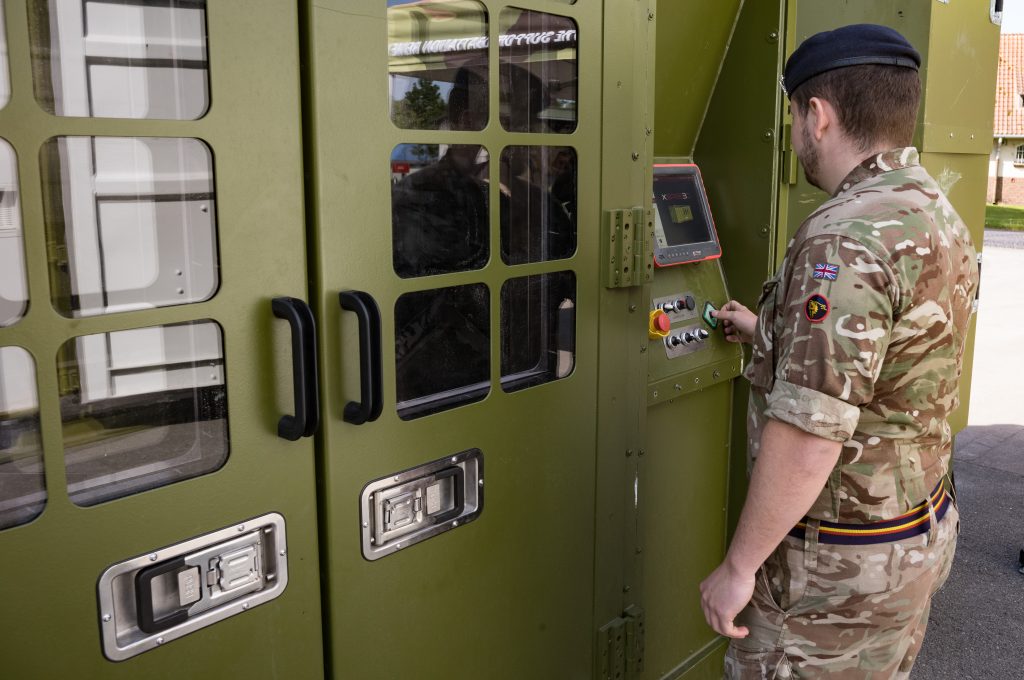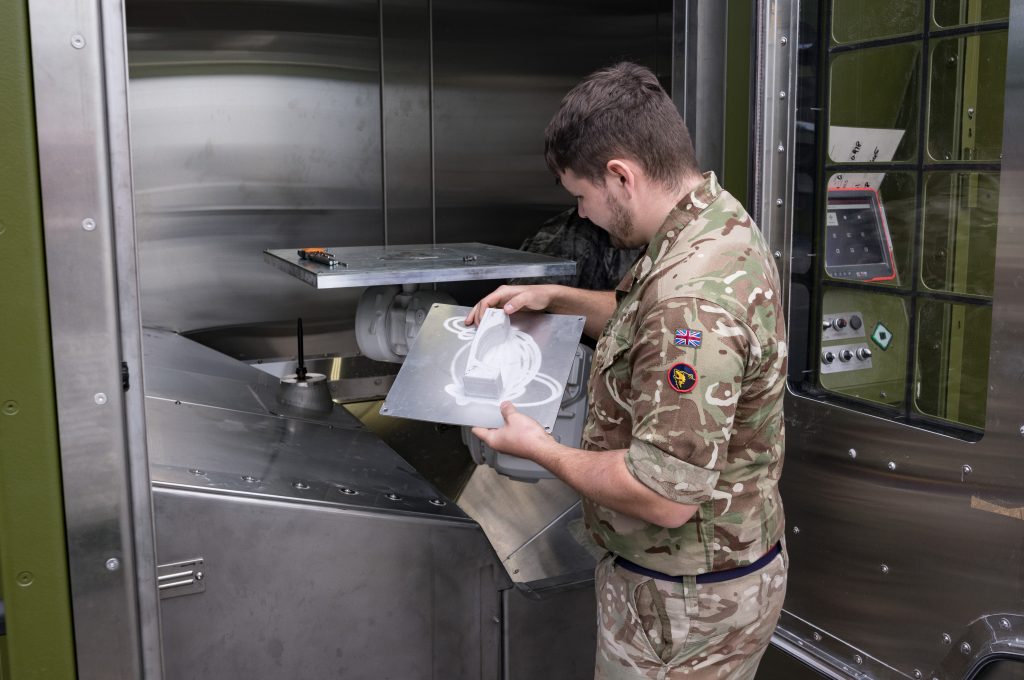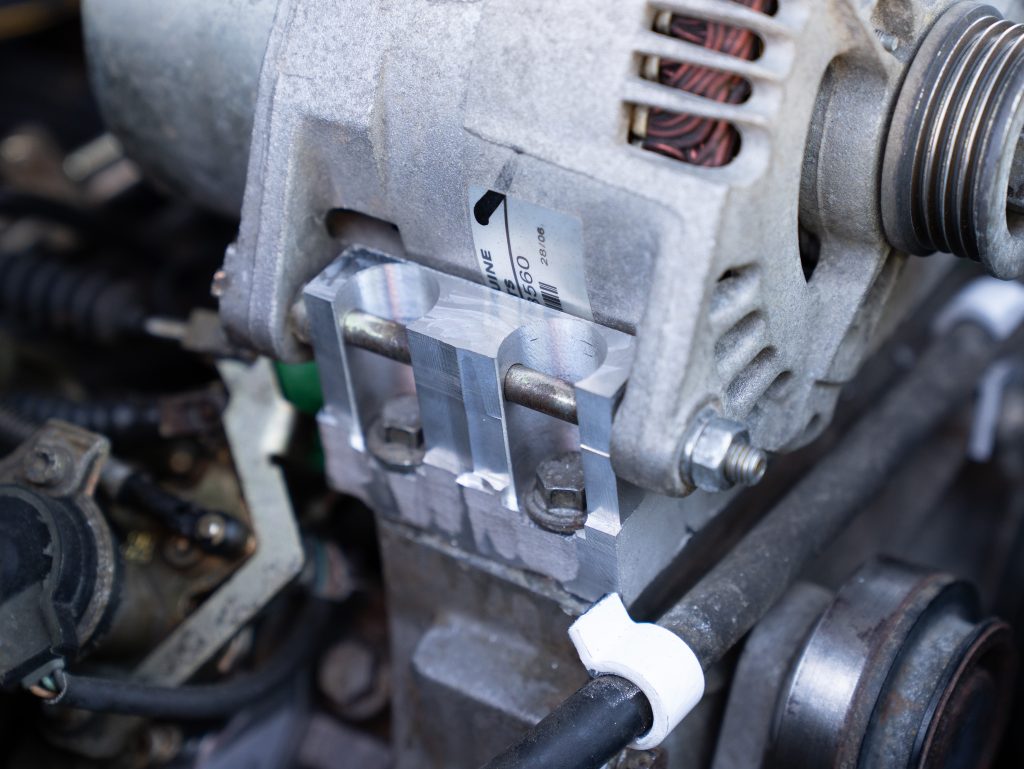The British Army is 3D printing spare parts in the field for the first time. Metal and polymer 3D printers are currently being used near the frontline at Steadfast Defender, NATO’s largest military exercise since the Cold War.
The Army’s metal additive manufacturing capabilities have been dubbed Project Brokkr. This includes an XSPEE3D cold spray 3D printer from Australian firm SPEE3D, which was purchased by the British Military last year.
The XSPEE3D, along with another unnamed polymer system, is being used by 9 Theatre Support Battalion, Royal Electrical and Mechanical Engineers (9 REME). The British troops are employing 3D printers to replace damaged or missing components for old vehicles, such as Land Rovers. These parts include caps for jerry cans, brackets for communications systems, and mounts found inside engine bays.
This is the first time the British Army has used 3D printers in the field as tactically deployed assets. Steadfast Defender also marks the first time additive manufacturing has been used in direct support of a large-scale NATO Exercise.
“This world-leading technology is another excellent example of how Britain is at the very forefront of innovation in Defence, providing our exemplary Armed Forces with a faster way to respond flexibly in the field,” commented UK Defence Secretary Grant Shapps. “Examples like this demonstrate that we are leading the way in developing new technologies to empower our Armed Forces and give them what they need to defend our nation.”

British Army deploying 3D printers in the field
The British Army’s 3D printers are built inside standardized containers, allowing them to be placed on the back of a truck and transported anywhere in the field. Unlike other laser-powered metal 3D printers, project Brokkr’s cold spray systems do not feature delicate components that can be easily damaged in transit. This makes them ideal for deployment to active military environments.
Cold spray technology, also known as Supersonic Particle Deposition (SPD), fabricates fully dense metal parts by firing metal powder at a substrate at three times the speed of sound. Through this process, the 3D printer follows a computer-aided design (CAD) to produce the part one layer at a time. The metal component is then subjected to post-processing, which includes heat treating, milling, and finishing.
Critically for military applications, cold spray 3D printing is fast. According to the Ministry of Defence (MoD), the British Army is able to produce critical metal parts where they are needed in less than an hour. Indeed, the XSPEE3D boasts a build rate of 100g/minute, with an ability to produce components up to ⌀0.9m x 0.7m in size in aluminum, aluminum bronze, stainless steel, or copper.

Complementing project Brokkr, 9 REME also possesses polymer 3D printing capabilities. Speaking with Forces News, Lieutenant Colonel John Anthistle, the Commanding Officer of 9 Theatre Support Battalion, called this a “polymer maker space system.” The polymer 3D printer has been placed on the back of a lorry and can be transported to the point of need to facilitate the production of spares and modifications in the field.
These additive manufacturing capabilities eliminate reliance on extended supply chains, which can take weeks or months to deliver replacement parts. According to a British Army press release, additive manufacturing boosts the efficiency and the speed of repair, cuts the cost of transport, and produces a much smaller carbon footprint.
During Steadfast Defender, 9 REME had based its 3D printing technology in Sennelager, Germany at what has been termed the ‘Field Army Additive Manufacturing Concentration.’ However, it has now re-deployed its 3D printers to Additive Manufacturing Village 2024, a military showcase run by the European Defence Agency.
Taking place in Belgium from 13-17 May, AM Village will see British soldiers compete with their European counterparts to repair damaged vehicles. The troops will work to diagnose the cause of a broken down vehicle, design a replacement part, 3D print it, install it and drive away.
Looking to the future, the British Army hopes to build up digital design catalogs for new fleets of vehicles such as BOXER and AJAX, allowing more parts to be 3D printed on demand in the field.

3D printing on the front lines
The British Army is not the only military force to recognize the benefits offered by deploying 3D printers on or near the frontlines. Last year, SPEE3D supplied seven of its WarpSPEE3D 3D printers to Ukraine through the US Department of Defence’s (DoD) Ukraine Security Assistance initiative.
The company also provided a 15-day training program to Ukrainian military personnel, educating them on how to fully utilize cold spray 3D printing in the field. SPEE3D’s Director of Defense Programs, Calum Stewart, told 3D Printing Industry that the company’s 3D printers enable troops to get “more equipment in the fight, more of the time.”
Like the XSPEE3D, WarpSPEE3D 3D printers can be deployed to difficult to reach areas, allowing key metal parts to be quickly produced when and where they are needed. “You can pick it up, put it in the back of a truck, put it down, set it up, and have it up and running in 45 minutes,” explained Stewart.
Another 3D printer manufacturer that is supporting Ukraine’s war effort is Essentium. Last year, the firm partnered with KVG to deploy its High-Speed Extrusion (HSE) 3D printers across several locations in the country. As with SPEE3D, Essentium supplied essential training on-site, to ensure the continuous and effective production of essential components.
Elsewhere, it was announced earlier this year that Additive manufacturing software company 1000 Kelvin had partnered with Norwegian Defence Research Establishment (FFI) spin-off Fieldmade. Through this collaboration, the two partners are working to enable the rapid deployment of 3D printers in active combat zones.
Specifically, 1000 Kelvin’s AMAIZE platform has been integrated into Fieldmade’s deployable additive manufacturing solutions. This includes its NOMAD series of transportable 3D printing modules. The companies claim that this integration will enable soldiers to start producing parts as soon as the module arrives on site.
Want to help select the winners of the 2024 3D Printing Industry Awards? Join the Expert Committee today.
What does the future of 3D printing hold?
What near-term 3D printing trends have been highlighted by industry experts?
Subscribe to the 3D Printing Industry newsletter to keep up to date with the latest 3D printing news.
You can also follow us on Twitter, like our Facebook page, and subscribe to the 3D Printing Industry Youtube channel to access more exclusive content.
Featured image shows a British solider operator the manufactured part after 3D printing is complete. Photo via the British Army.


